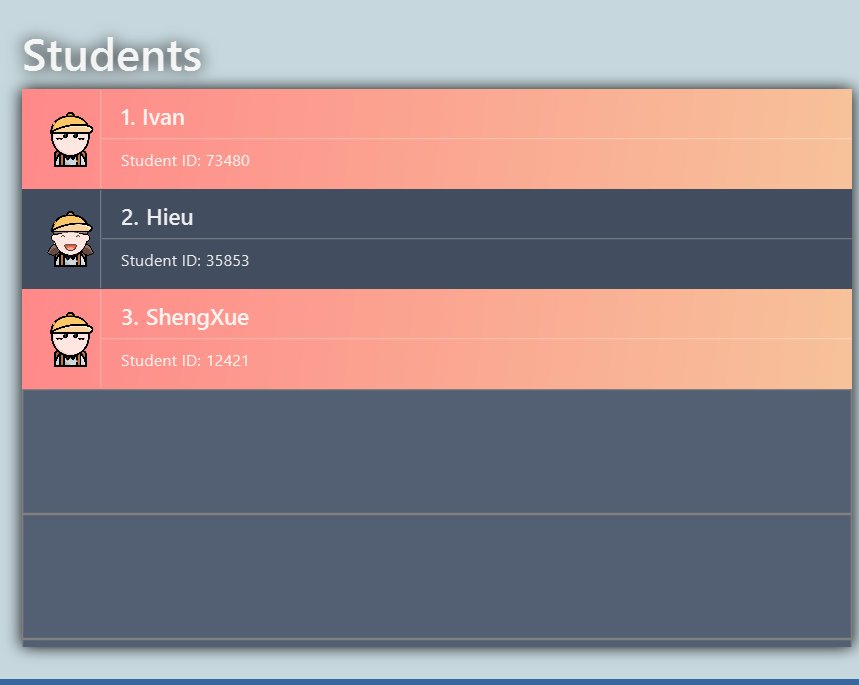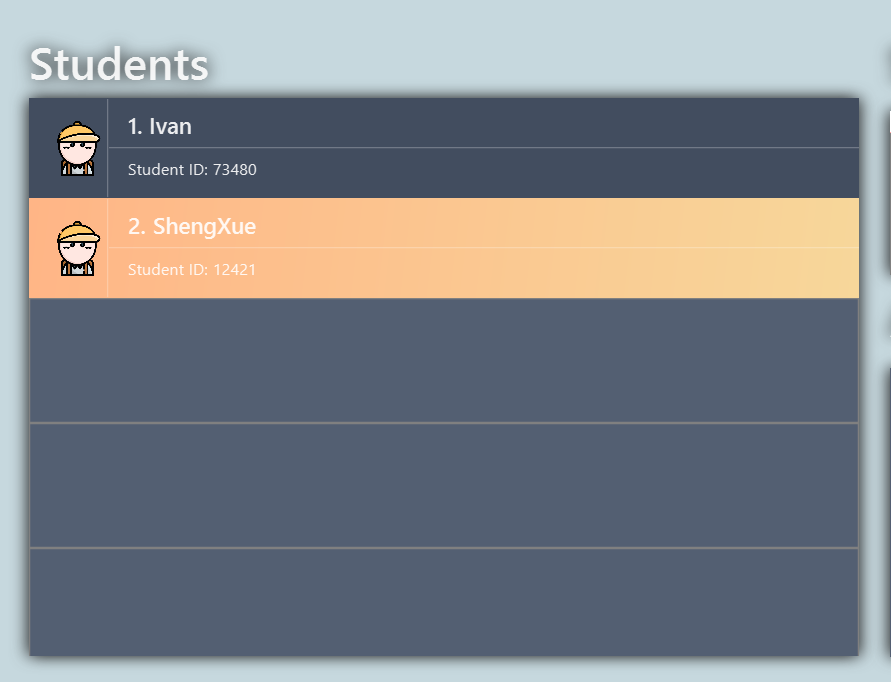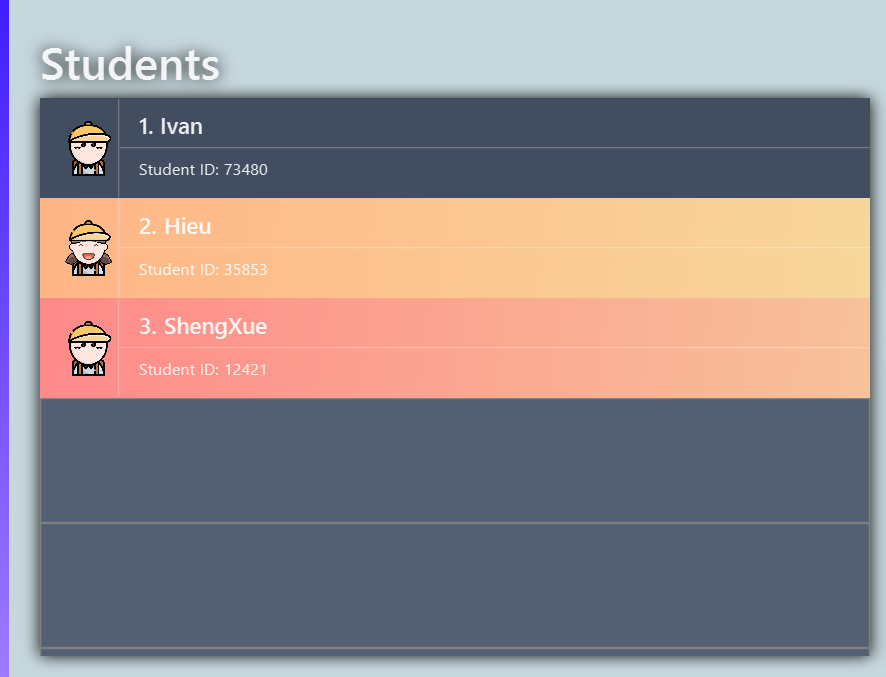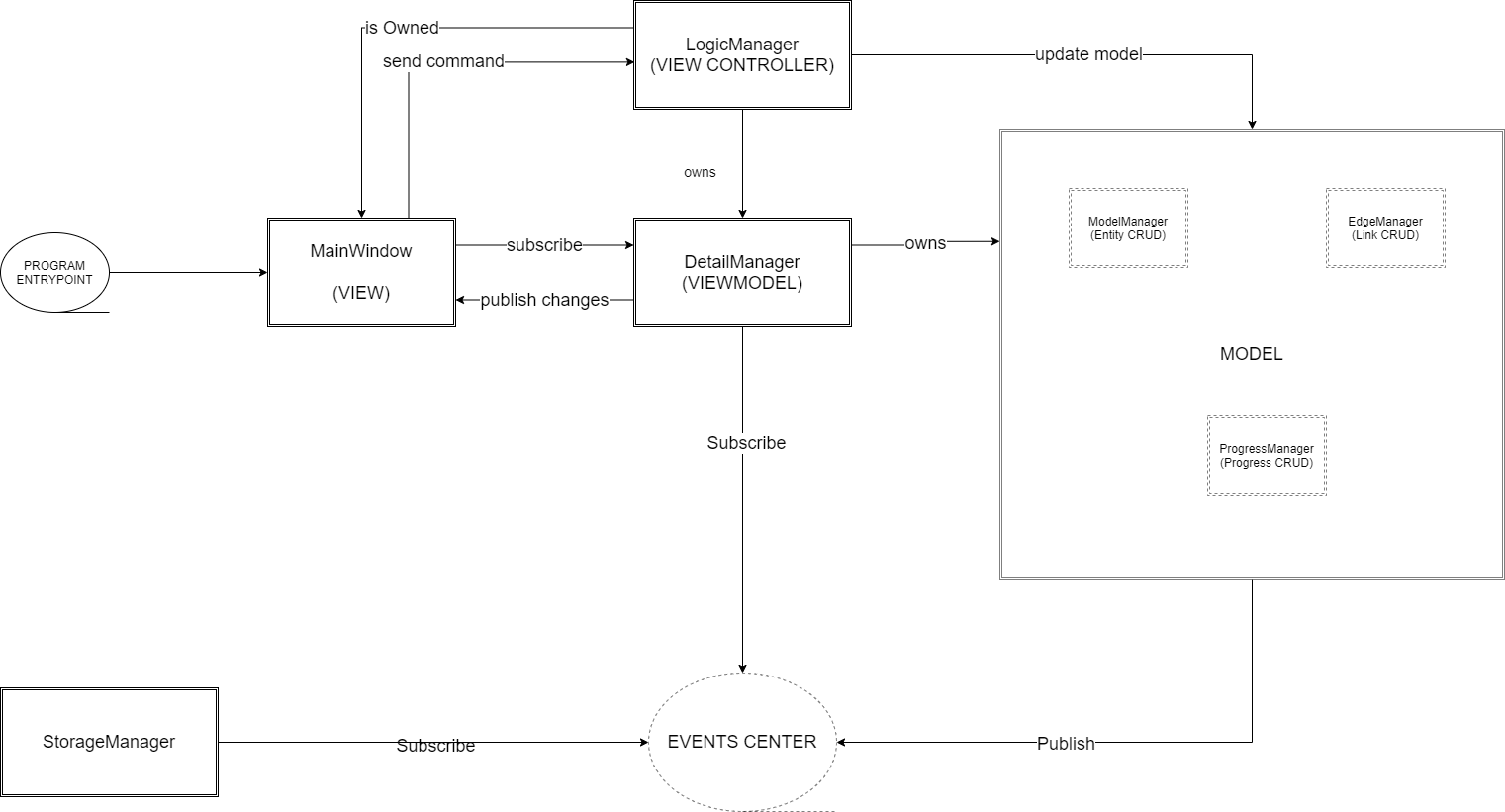Summary of Contributions:
-
Major enhancement:
-
Develop undo-redo feature main template and then extend for add / delete
-
Default suggested implement: The entire memory contents of the app was stored at every step.
-
Current Implementation: Each command that changes the state of the app will learn how to undo/redo itself.
-
Reason: This will significantly reduce memory consumption of the app, but with the cost of more complicated implementation.
-
-
Build the architecture design interactions, this includes
-
Building EventsCenter and BaseManager and events classes, which have different methods for event-firing and event-handling.
-
Enforce and abstract out responsibility for different managers, bind code here and then to follow MVVM structure.
-
Building ViewModel which keeps track of observableMap that the UI uses, and handles events as well as query from managers to update ViewModel automatically
-
-
-
Minor enhancement:
-
Build factory pattern design and template for assign command.
-
Code refactoring: Examples: Refactor all model and addressBook related stuff under modelGeneric and extends from that, then in return methods in ModelManager becomes generic as well.
-
Develop UUID Manager to auto-assign unique random ID for new entities in the system. Abstract out EdgeManager (which is in charge of consistency of linking relationship between entities) , and event-handling of EdgeManager.
-
Bind stuff here and there for event-flow design.
-
Selectcommand to view details of different entities, andselectcan be in 2 layers as well for lazy loading. For example:select sid/ student_idwill show the list of courses of this student, but if we want to see details of this student progress under a course then needselect sid/ student_id cid/ course_id
-
-
Code contributed: [Functional and Test Code]
-
Other contributions:
-
Project Structure communication:
-
Discuss details of implementation with different team members before implemented to ensure the overall architecture flow and design principles are met and consistent.
-
-
Project Management:
-
Contributions to the User Guide
Undo Command: undo
Set the app state back to the most recent undoableCommand.
|
See the full list of undoable commands: all edit/add/delete/assign/unassign commands. |
Examples:
-
find-student hieu
undo
This will fail because find-student is not an undoableCommand.
-
delete-student 35853
undo
Undo the delete command of student and add the student back at the previous relative ordering too.
Illustration:

After delete-student 35853

After undo:

Redo Command: redo
Reverses the most recent undo command, but will fail if the most recent command was not the undo command or redo
command
Examples:
-
delete-student 35853
undo
redo
Successfully delete the student, then add the student back with undo, then delete student again with redo
-
find-student hieu
redo
redo fails because no undo command previously
-
delete-student 35853
undo
find-student hieu
redo
This redo also fails because the most recent command is not undo or redo
Contributions to the Developer Guide
Architecture (HIEU)

The Architecture Diagram given above explains the high-level design of the App. Given below is a quick overview of each component.
Design Pattern and Control Flow
Two main design patterns were used in the design of our software.
- Model - View - ViewModel (MVVM) Control Flow
-
Design Consideration between Model-View-Controller(MVC) and Model-View-ViewModel(MVVM) design:
-
The original design was a standard MVC, where Controller is our LogicManager, and the Model is our ModelManager. Then components in the view will bind to the model objects, whenever there is an update to the model object the UI view will be updated automatically.
-
However, the more UI custom views logic we decide, we might need to push more and more custom UI-specific logic to our Model and ViewController class, which is not very desirable. Or as the infamous quote, MVC becomes "Massive View Controller".
-
Instead, we will adapt to MVVM design, where ViewModel will hold a list of observableMap of data. Each custom view in our UI will have a one-to-one mapping with an observableMap, and to calculate those observableMap the ViewModel will make use of the Managers we define.
-
- Event-Driven Design
-
We adopt event-driven design, where different components will try to communicate with each other through publishing events and subscribing to events, de-couple between components, and facilitate communication between components a lot.
-
To separate responsibilities well between components, we divide them into multiple managers, all extending from the BaseManager class. The BaseManager will always hold refer to the EventsCenter (which is designed to be a singleton class in our case)
-
One is publishing managers (those in Model section, i.e EdgeManager, ProgressManager, etc). They can post events to the EventsCenterSingleton.
-
The other one is subscribing managers, one is the ViewModel (which is DetailManager) and StorageManager. Subscribing managers will have handler method that listen to the events and decide what to do.
-
-
Different events types will extend from the BaseEvent. In our app we have
-
DataStorageChangeEvent: signals when model object changes
-
DeleteEntitySyncEvent: signals when the entity linking relationship is broken (e.g when a student is deleted, its link to course and progress and teacher, etc will be broken)
-
-
Here is an example of how a command to delete student with ID 1 will invoke different parts along the flow.

-
ViewController(i.e LogicManager) will invoke ModelManager.delete method (Note that ModelManager extends from BaseManager, and has the Publisher capacity)
-
ModelManager will invoke publishing of events to EventsCenterSingleton (which holds an EventBus), in this case postDataStorageChangeEvent and postDeleteEntitySyncEvent will be invoked.
-
Other BaseManagers will also hold this EventsCenterSingleton and listen to new publish events in the event bus. If the manager class has the handler function for that types of events, the method will be invoked.
-
In this case, StorageManager will have handler for both DataStorageChangeEvent and DeleteEntitySyncEvent, while ViewModel will have handler for DataStorageChangeEvent.
ViewModel component (HIEU)

API: ViewModel.java
The ViewModel,
-
stores a list of
observableMap, each map will corresponds to oneDetailPanelin ui folder. -
Each
DetailPanel(in MainWindow) will listen to theViewModelthrough the Logic layer. -
the
ViewModelwill then query the managers fromModellayer to update its observableMap, which in turn will automatically update the correspondingDetailPanelview.
Undo/Redo [Hieu]
Currently we only support undo/redo for commands that modify the storage (or state of the app). I.e add / delete, assign / un-assign, edit commands.
View Controller (LogicManager) will hold UndoRedoStack class, which stores the undoStack and redoStack which will be explained below.
Those commands listed above will inherit from UndoableCommand abstract class. UndoableCommand will extends from Command class.
UndoableCommand will contain the general algorithm flow for doing undo/ redo, while there will be some details delegated to the actual command class. This technique is also known as template pattern.
public abstract class UndoableCommand extends Command {
public abstract void preprocessUndoableCommand() {}
public abstract void generateOppositeUndoableCommand();
public CommandResult executeUndoableCommand();
@Override
public CommandResult execute() {
preprocessUndoableCommand();
generateOppositeUndoableCommand();
return executeUndoableCommand();
}
}Note that for each UndoableCommand, before execution, it needs to save some information (through the preprocessUndoableCommand) then generate (and store) the opposite corresponding command (through generateOppositeUndoableCommand)
Let’s go through the example in diagram below. - The user first executes a new UndoableCommand delete-student. Before this delete command is executed, we preprocessUndoableCommand to get the to-be-deleted student object, as well as the current index of this student object in list.
-
Then we will generate a AddStudentCommand (which is opposite of this DeleteStudentCommand) with this studentObject and index and push it to undoStack
-
When undo command is executed, the top of undoStack is popped out, then pushed to redoStack. Then the oppositeCommand of it will be excecuted (in this case AddStudentCommand will be invoked)
-
When redo command is executed, the top of redoStack is popped out, then pushed to undoStack. Then the originalCommand will be executed (again) (in this case it will be DeleteStudentCommand again).

-
Design Considerations: 1/ How Undo and Redo works: Option A: Save the entire app state after every command. Pros: Very easy implementation. Cons: Serious memory performance issue when storing the whole address book at every time step.
Option B (Current choice): Each (undoable) command will know how to generateOpposite command itself. Pros: Reduce a lot of memory issue.
Cons: Harder to implement
View Switching [HIEU]
To see sub-view details of each section we can issue a select command.
Let’s see an example of how selecting sub-view data of a student 1 works.

-
select sid/ 1command is issued toViewController -
ViewControllerwill callViewModelmethodupdateStudentDetailsMap -
In turn, that method will invoke managers from
Modellayer, for exampleModelManager, to updateobservableStudentDetailMapinsideViewModel -
Because
StudentDetailsMapimplements anonChangefunction that listen to update inobservableStudentDetailMap, the UI part will be updated correspondingly with data of this student 1.
Design considerations:
-
Automatically updating the UI sub-view when the app state changes. Let’s say the current sub-view shown in the UI is of the details of student 1, then some information of the course of that student is changed, or the student is removed from the course, the UI should update immediately without the need to issue the click command again. To support that, our
ViewModelwill listen toEventsCenter, then whenever an event ofDataStorageChangeEventorDeleteEntitySyncEventhappens, it will check whichobservableMap(which corresponds to differentDetailedView) is active then do the query again. -
Lazy loading: For example, when seeing details of the students, we only want to show the courses that the students have without the progresses of this course that the student currently have. To query that, after executing
select sid/ student_id, the user needs to runselect sid/ student_id cid/ course-idas well